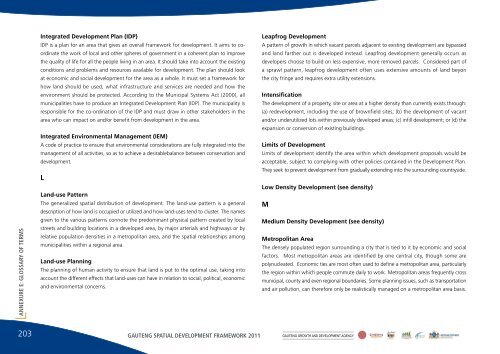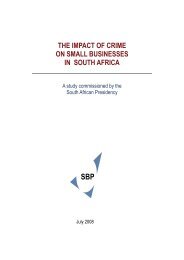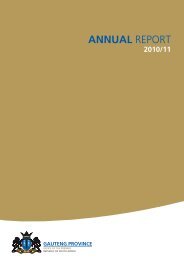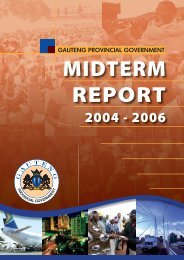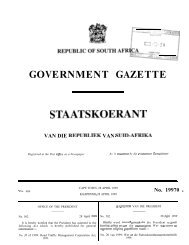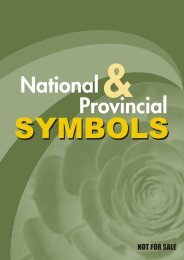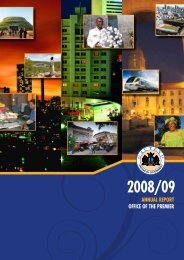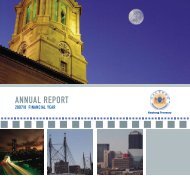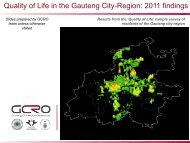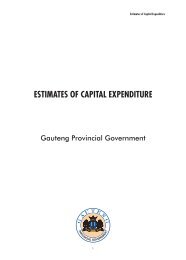the gauteng spatial development framework - Gauteng Online
the gauteng spatial development framework - Gauteng Online
the gauteng spatial development framework - Gauteng Online
You also want an ePaper? Increase the reach of your titles
YUMPU automatically turns print PDFs into web optimized ePapers that Google loves.
ANNEXURE E: GLOSSARY OF TERMSIntegrated Development Plan (IDP)IDP is a plan for an area that gives an overall <strong>framework</strong> for <strong>development</strong>. It aims to coordinate<strong>the</strong> work of local and o<strong>the</strong>r spheres of government in a coherent plan to improve<strong>the</strong> quality of life for all <strong>the</strong> people living in an area. It should take into account <strong>the</strong> existingconditions and problems and resources available for <strong>development</strong>. The plan should lookat economic and social <strong>development</strong> for <strong>the</strong> area as a whole. It must set a <strong>framework</strong> forhow land should be used, what infrastructure and services are needed and how <strong>the</strong>environment should be protected. According to <strong>the</strong> Municipal Systems Act (2000), allmunicipalities have to produce an Integrated Development Plan (IDP). The municipality isresponsible for <strong>the</strong> co-ordination of <strong>the</strong> IDP and must draw in o<strong>the</strong>r stakeholders in <strong>the</strong>area who can impact on and/or benefit from <strong>development</strong> in <strong>the</strong> area.Integrated Environmental Management (IEM)A code of practice to ensure that environmental considerations are fully integrated into <strong>the</strong>management of all activities, so as to achieve a desirablebalance between conservation and<strong>development</strong>.LLand-use PatternThe generalized <strong>spatial</strong> distribution of <strong>development</strong>. The land-use pattern is a generaldescription of how land is occupied or utilized and how land-uses tend to cluster. The namesgiven to <strong>the</strong> various patterns connote <strong>the</strong> predominant physical pattern created by localstreets and building locations in a developed area, by major arterials and highways or byrelative population densities in a metropolitan area, and <strong>the</strong> <strong>spatial</strong> relationships amongmunicipalities within a regional area.Land-use PlanningThe planning of human activity to ensure that land is put to <strong>the</strong> optimal use, taking intoaccount <strong>the</strong> different effects that land-uses can have in relation to social, political, economicand environmental concerns.Leapfrog DevelopmentA pattern of growth in which vacant parcels adjacent to existing <strong>development</strong> are bypassedand land far<strong>the</strong>r out is developed instead. Leapfrog <strong>development</strong> generally occurs asdevelopers choose to build on less expensive, more removed parcels. Considered part ofa sprawl pattern, leapfrog <strong>development</strong> often uses extensive amounts of land beyon<strong>the</strong> city fringe and requires extra utility extensions.IntensificationThe <strong>development</strong> of a property, site or area at a higher density than currently exists through:(a) re<strong>development</strong>, including <strong>the</strong> use of brownfield sites; (b) <strong>the</strong> <strong>development</strong> of vacantand/or underutilized lots within previously developed areas; (c) infill <strong>development</strong>; or (d) <strong>the</strong>expansion or conversion of existing buildings.Limits of DevelopmentLimits of <strong>development</strong> identify <strong>the</strong> area within which <strong>development</strong> proposals would beacceptable, subject to complying with o<strong>the</strong>r policies contained in <strong>the</strong> Development Plan.They seek to prevent <strong>development</strong> from gradually extending into <strong>the</strong> surrounding countryside.Low Density Development (see density)MMedium Density Development (see density)Metropolitan AreaThe densely populated region surrounding a city that is tied to it by economic and socialfactors. Most metropolitan areas are identified by one central city, though some arepolynucleated. Economic ties are most often used to define a metropolitan area, particularly<strong>the</strong> region within which people commute daily to work. Metropolitan areas frequently crossmunicipal, county and even regional boundaries. Some planning issues, such as transportationand air pollution, can <strong>the</strong>refore only be realistically managed on a metropolitan area basis.203 GAUTENG SPATIAL DEVELOPMENT FRAMEWORK 2011 GAUTENG GROWTH AND DEVELOPMENT AGENCY


